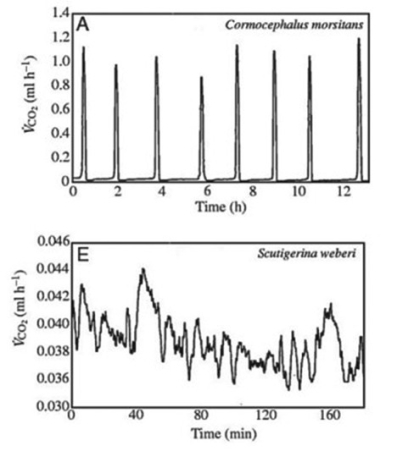Many terrestrial arthropods exchange gases with their environments by using tracheae, tubes that lead from openings (called spiracles) in the animal's exoskeleton or cuticle directly to the animal's tissues. Some arthropods can control whether their spiracles are opened or closed; opening the spiracles allows the carbon dioxide produced in the tissues to travel down the tracheae and be released outside the animal. Klok et al. measured the carbon dioxide emitted over time (represented by VCO₂) by several species of centipedes. The figures present graphs of their results for two species, Cormocephalus morsitans and Scutigerina weberi. (C. J. Klok, R. D. Mercer, and S. L. Chown. 2002. Discontinuous gas-exchange in centipedes and its convergent evolution in tracheated arthropods. Journal of Experimental Biology 205:1019-29.) Copyright 2002 The Company of Biologists and the Journal of Experimental Biology. 
Compare the graphs in the figure of carbon dioxide (CO₂) emission for Cormocephalus morsitans and Scutigerina weberi.
-What hypothesis can you make about each centipede's habitat?
Definitions:
Annual Family Income
The total amount of money earned by all members of a family within one year.
Income Distribution
The way in which total income is shared amongst the members of a society, often analyzed to understand the extent of economic inequality.
Before-Tax Income
The total income earned by an individual or corporation before taxes have been deducted.
Welfare Reforms
Changes or amendments to a country’s welfare policy aimed at improving the effectiveness and efficiency of its social security and aid programs.
Q9: Similar to most amoebozoans, the forams and
Q15: Apical meristems of dicots are at the
Q23: Parasitism is one of the most widespread
Q26: If you were able to walk into
Q31: Healthy corals are brightly coloured because they
Q35: The various taxonomic levels (for example, phyla,
Q38: In prokaryotes, new mutations accumulate quickly in
Q54: Breeuwer et al. (2008) measured the effect
Q54: Many flowering plants coevolve with specific pollinators.
Q60: The common ancestor of the protostomes had